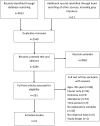Factors associated with older people's emergency department attendance towards the end of life: a systematic review
- PMID: 30481305
- PMCID: PMC6345149
- DOI: 10.1093/eurpub/cky241
Factors associated with older people's emergency department attendance towards the end of life: a systematic review
Abstract
Background: Emergency department (ED) attendance for older people towards the end of life is common and increasing, despite most preferring home-based care. We aimed to review the factors associated with older people's ED attendance towards the end of life.
Methods: Systematic review using Medline, Embase, PsychINFO, CINAHL and Web of Science from inception to March 2017. Included studies quantitatively examined factors associated with ED attendance for people aged ≥65 years within the last year of life. We assessed study quality using the QualSyst tool and determined evidence strength based on quality, quantity and consistency. We narratively synthesized the quantitative findings.
Results: Of 3824 publications identified, 21 were included, combining data from 1 565 187 participants. 17/21 studies were from the USA and 19/21 used routinely collected data. We identified 47 factors and 21 were included in the final model. We found high strength evidence for associations between ED attendance and palliative/hospice care (adjusted effect estimate range: 0.1-0.94); non-white ethnicity (1.03-2.16); male gender (1.04-1.83, except 0.70 in one sub-sample) and rural areas (0.98-1.79). The final model included socio-demographic, illness and service factors, with largest effect sizes for service factors.
Conclusions: In this synthesis, receiving palliative care was associated with lower ED attendance in the last year of life for older adults. This has implications for service models for older people nearing the end of life. However, there is limited evidence from European countries and none from low or middle-income countries, which warrants further research.
Figures



Similar articles
-
Emergency department attendance by patients with cancer in the last month of life: a systematic review and meta-analysis.Lancet. 2015 Feb 26;385 Suppl 1:S41. doi: 10.1016/S0140-6736(15)60356-7. Lancet. 2015. PMID: 26312863
-
Patterns of emergency department attendance among older people in the last three months of life and factors associated with frequent attendance: a mortality follow-back survey.Age Ageing. 2019 Sep 1;48(5):680-687. doi: 10.1093/ageing/afz043. Age Ageing. 2019. PMID: 31127300
-
Palliative care experiences of adult cancer patients from ethnocultural groups: a qualitative systematic review protocol.JBI Database System Rev Implement Rep. 2015 Jan;13(1):99-111. doi: 10.11124/jbisrir-2015-1809. JBI Database System Rev Implement Rep. 2015. PMID: 26447011
-
What is the evidence for the management of patients along the pathway from the emergency department to acute admission to reduce unplanned attendance and admission? An evidence synthesis.BMC Health Serv Res. 2017 May 16;17(1):355. doi: 10.1186/s12913-017-2299-8. BMC Health Serv Res. 2017. PMID: 28511702 Free PMC article. Review.
-
Factors influencing the decision to convey or not to convey elderly people to the emergency department after emergency ambulance attendance: a systematic mixed studies review.BMJ Open. 2018 Aug 30;8(8):e021732. doi: 10.1136/bmjopen-2018-021732. BMJ Open. 2018. PMID: 30166299 Free PMC article.
Cited by
-
A multi-stage process to develop quality indicators for community-based palliative care using interRAI data.PLoS One. 2022 Apr 7;17(4):e0266569. doi: 10.1371/journal.pone.0266569. eCollection 2022. PLoS One. 2022. PMID: 35390091 Free PMC article.
-
End-of-Life Care during the COVID-19 Pandemic: Decreased Hospitalization of Nursing Home Residents at the End of Life.Healthcare (Basel). 2024 Aug 8;12(16):1573. doi: 10.3390/healthcare12161573. Healthcare (Basel). 2024. PMID: 39201132 Free PMC article.
-
Nursing Home Residents Hospitalization at the End of Life: Experience and Predictors in Portuguese Nursing Homes.Int J Environ Res Public Health. 2023 Jan 4;20(2):947. doi: 10.3390/ijerph20020947. Int J Environ Res Public Health. 2023. PMID: 36673703 Free PMC article.
-
What is a compassionate response in the emergency department? Learner evaluation of an End-of-Life Essentials online education module.Emerg Med Australas. 2021 Dec;33(6):983-991. doi: 10.1111/1742-6723.13776. Epub 2021 May 5. Emerg Med Australas. 2021. PMID: 33951282 Free PMC article.
-
Association between ethnicity and emergency department visits in the last three months of life in England: a retrospective population-based study using electronic health records.BMJ Public Health. 2024 Oct 18;2(2):e001121. doi: 10.1136/bmjph-2024-001121. eCollection 2024 Dec. BMJ Public Health. 2024. PMID: 40018585 Free PMC article.
References
-
- Gott M, Seymour J, Bellamy G et al. . Older people’s views about home as a place of care at the end of life. Palliat Med 2004;18:460–7. - PubMed
-
- Marie C. Emergency admissions: data briefing. 2018. Available at:https://www.mariecurie.org.uk/globalassets/media/documents/policy/policy....
Publication types
MeSH terms
LinkOut - more resources
Full Text Sources
Medical

